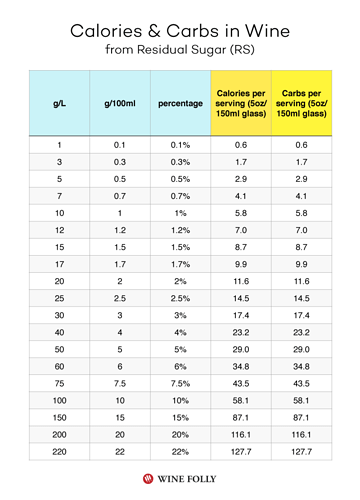So, after going down the rabbit hole of Google last week, Im wondering…besides residual sugar and glycerol, are there any other carbs in wine?? I want to be corrected if Im wrong, but I honestly cant find any other literature suggesting there is any more to it. (YES, i get that drinking alcohol will slow down fat loss) All the research I have done suggests that there are no MEASURABLE carbs in wine, ie. 100% - what they can measure= left over calories, which they label carbs (including glycerol). Besides RS (which is in your face, straight up sugar) and glycerol, what else is there, carb-wise???
REAL wine
Sorry for the non-scientific response but I’ve noticed that wine is more likely to make me want a snack even if I know darn well that I’ve had enough to eat. I’ve been assuming that this was related to carb content.
Anyway, I’ll be following this thread to see if someone posts anything of substance.
Cheers.
While glycerol does have a sweet taste to humans, it’s an alcohol itself. The human body can make glucose from it, but very few wines have enough for us to even sense it (despite claims that it gives a viscous “mouthfeel”) - that’s going to be something like late-harvest icewine or super-sweet high-end German Rieslings.
Residual sugar is really the only carbohydrate in wine to worry about. Dry wines are second only to pure hard liquors as far as being low-carb. We also experience the fruit aspect of wine taste as “sweet,” even if there is little actual sugar present. Young wines with a given residual sugar content will usually taste sweeter than they do with years of age on them, even as the sugar content remains the same.
So when the only remarkable quantity of carbs comes from the residual sugar the estimations you can find e.g. here
https://www.dietdoctor.com/low-carb/drinks
are a little bit exxagerated. Dry wine contains typically 2-5 g/l sugar hence you find in a glass of 150 ml typically less than 1g carbs.
I thinking grouping them into categories is very misleading as the sugar content between one type of wine (merlot, cab, chardonnay, champagne, etc) and another can vary widely.
At least here in Germany the terms dry, medium dry, sweet… are defined by rules and do not depend on the type of wine. They are defined by the quantity of sugar.
I agree - for most of us, with dry wines the quantity of alcohol would be a concern before the amount of sugar.
It certainly can vary a lot. Most countries don’t require labeling for the sugar content. Many producers do provide technical information on their wines, but it may take a little internet digging to find it. To some extent, it’s a minefield - the more acidic and tannic a wine is, the less we will taste the sugar in it. Higher-quality wines tend to use better grapes to start with, with a more pronounced ‘fruit’ aspect, ending up tasting somewhat sweeter regardless of actual residual sugar concentration - overall, cheaper wines, “grocery store” wines, etc., will have more sugar than more expensive ones. Exceptions are German wines, ports, icewine, sauternes, dessert wines in general.
A good online store for wine should declare values like sugar, acidity and alcohol.
I agree!! I was pointed to http://www.lcbo.com/content/lcbo/en.html#.XCuRolxKiM8 in a Reddit thread, and find it to be the most helpful. The only comparable, and most comprehensive site in my area would be Total Wine, and they do not list the information. I know what wines I like, so browsing for info before I go to the store makes it a little less stressful when Im actually shopping. The wine guy at my liquor store is very informed about wines, but even he (without the spec sheet) could not give me the information I need, and I dont feel like using up his time for something that I can figure out on my own.
Tech sheets:
https://winefolly.com/review/understanding-wine-tech-sheets/
Not every vintner will produce a tech sheet or publish it on the web. Smaller producers are less likely to do the analysis or publish it.
Different varietals and production methods produce a range of sugar contents. As noted, ice wines, late harvest, noble rot, raisination or other dessert processes will have high RS, as will fortified products like Port and Madeira. Wine grapes are higher sugar content than table grapes. Makes sense as the fermentation requires sugar to convert to alcohol, and your standard table grape just doesn’t have enough sugar to make enough alcohol to make it worthwhile. Zin grapes are absurdly high sugar, hence the sweetness of white zin and the high alcohol contents and RS numbers for red zin.
https://winefolly.com/review/sugar-in-wine-chart/
Dry is generally a good guideline, but worth investigating anyway.
Yeah, I think they screwed that chart up. If a wine has 10g/L, it’s 1.5g carb for a 5 Oz/150 ml pour. That’s 6 calories from carb, plus whatever alcohol there is. The calories in a glass of wine will be semi dependent on the sugar, but alcohol is caloric (7 kcal per g), and is semi-independent from the residual sugar.

